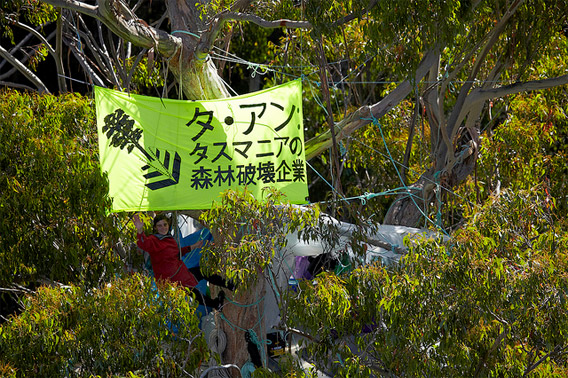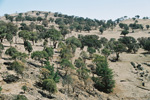
Miranda Gibson in the Observer Tree. Photo courtesy of Gibson.
A bushfire has forced an environmental campaigner from the top of a tree following a 449-day vigil to block logging of a stand of old-growth forest in Australia.
Miranda Gibson, 31, has been perched 60 meters of an ancient gum tree in southwestern Tasmania since December 14, 2011. From the tree she has led a media campaign using her solar-powered computer to block a Malaysian company from logging the surrounding area. The company, Ta Ann, has been linked to destruction of rainforests in Borneo, yet markets its products as eco-friendly.
Gibson decided to leave the giant gum — dubbed the Observer Tree, as a safety precaution due to a nearby blaze. She said the campaign will continue however.
“Nature can be wild and unpredictable, and whilst I was able to withstand winter snow and summer heat exposed to the elements 60 metres up the Observer Tree, it is the sensible and safe decision to climb down now rather than put lives at risk with the bushfire so close,” Ms Gibson said.
“Our campaign to stop the logging of these World Heritage nominated forests and of the proposed protected areas will continue despite my exit from the Observer Tree. Although it is disappointing to leave this forest whilst these precious places continue to fall to the chainsaw, I have a huge respect for the forces of nature that are in play. And I remain as dedicated as ever to standing up for Tasmania’s threatened forests. ”

Miranda Gibson send a message to Ta Ann’s corporate customers in Japan. Courtesy of Gibson.
Logging in Tasmania’s old growth forests has been a hot-button issue for decades, pitting environmentalists against loggers. One of the island’s most notorious loggers, Gunns, went into liquidation this week with more than $750 million in debt.
Related articles
Forests under fire: Australia’s imperiled south west

(03/05/2013) In the far southwestern corner of Western Australia, beyond the famed wineries in the shadow of the Margaret River, lies an ecosystem like no other, the South West ecoregion. This part of Australia has been identified as one of 34 global biodiversity hotspots, home to rare endemic flora and fauna like the Carnaby’s black cockatoo, numbat (banded anteaters), woylie (brush-tailed bettong), mainland quokka and over 1500 plant species, most found nowhere else. Unfortunately, this unique habitat is being increasingly fragmented and its inhabitants threatened by a number of forces, including climate change, dieback, fires and logging. And, on the eve of the Western Australia’s state elections, the future of the South West hangs in the balance.
A Tasmanian tragedy? : How the forestry industry has torn an island apart

(07/02/2009) This is by no means a new battle: in fact, Tasmanian industrial foresters and environmentalists have been fighting over the issue of clearcutting the island’s forests for decades. The battle—some would probably prefer ‘war’—is over nothing less than the future of Tasmania. Some Tasmanians see the rich forests that surround them in terms of income, dollars and cents; they see money literally growing on trees, or more appropriately growing on monoculture plantations and government owned native forests. They see the wilderness of Tasmania as an exploitative resource.
The living dead – Australia’s disappearing landscape

(06/24/2009) Gum trees dot the hills and valleys of south-eastern Australia, a vivid fixture of the rolling landscape. But despite the seeming health of these iconic trees, they have earned the morbid nickname “the living dead” among ecologists, who say natural changes and human actions are threatening the next generation of gum trees. The gum trees that are scattered through the landscape are naturally dying off at a rate of one to two percent each year. With no replacement, researchers fear more than 100,000 square kilometers of land could be virtually treeless within the next 100 years.